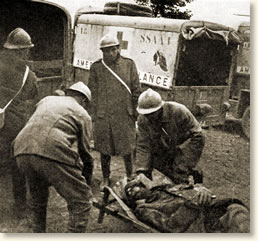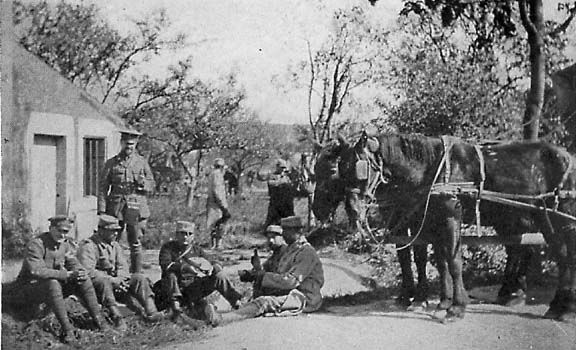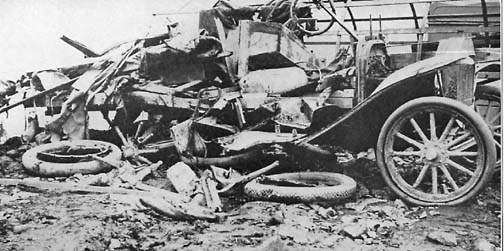In Ghostwriter, Seth was a member of the American Ambulance Field Service during WWI.
The American Hospital at the Lycée Pasteur in Neuilly, just outside of Paris, was opened in 1914 in an unfinished school building. The hospital was staffed by volunteers -- Americans living in Paris -- until the US entered the war. Money was solicited from donors, ambulance vehicles purchased, but the need proved greater than the volunteers could serve. In 1915, the French government approved a plan to solicit volunteers from within the United States itself.
The young men were recruited mostly from American universities. One of the founders, J. Piatt Andrew, had been a professor at Harvard. Recruiters were sent to the campuses, including Harvard and Yale, and Duke, the university Seth attends in Ghostwriter.
In the early 20th century, college was still a province of the elite. The GI bill had not been established, nor the extensive student loan system we have today. These were the sons of privileged families, which was necessary as the volunteers had to pay for their own uniforms and their travel expenses.
When John Masefield, the British poet, referred to the ambulance drivers as "the finest young men of America, the very pick and flower of the graduates and undergraduates of the universities" he was not exaggerating. Drivers were picked. The professor doing the recruiting was at the same time screening the applicants. Not everyone with five hundred and fifty dollars was allowed to join the services. The American Field Service required that volunteers "have letters of recommendation from six persons of standing" in their community. They cautioned drivers to 'remember that you are volunteers going to France for a lofty purpose and that you belong to an organization that has maintained the highest standards. -- James T. Lapsley III, Gentlemen Volunteers. American Ambulance Drivers in the First World War. (Master's thesis at UC Santa Cruz, 1971).

The recruiters appealed to the volunteers on the basis of the long-standing friendship between the United States and the French, who assisted us during the Revolutionary War.
"Gayley in a stirring impromptu speech recalled the long, historical friendship between France and the United States, and emphasized the need that the men chosen for the Corps should not only be willing workers but also entirely loyal to France and her cause. He raised the audience to a pitch of generous enthusiasm. Forthwith one hundred and ten men signed pledges signifying their willingness to take part in this humanitarian service." -- The AFS Story
The volunteers were paid the equivalent of thirty-four cents a week, the same as a French soldier earned. (By comparison, a French factory worker earned sixty times as much.) Their meals and lodging were provided and though they technically had no rank, they were treated as officers.
 |
| AFS drivers and French soldiers sharing lunch |
By the time the US had entered the war and the AFS was merged with the Army, they had over 2,500 volunteers, who served in nearly every major battle of WWI. Despite their non-combat role, their service was very dangerous. Over 250 of them were killed in the line of duty, including 21 from Harvard University.
Many of the men wrote about their experiences in letters and newsletters sent home to their families, and later, in a book of memoirs they published:
Through deserted, shell-shattered villages we ploughed, the mud spraying us from tires to top and filling our eyes, over the wind-break. It was nearing dusk as we reached the poste, a dugout in the side of a hill. Just above us, on the crest was the line and we could hear distinctly the popping of hand-grenades between the battery salvos. Our men, one shot through the leg, the other hit in the chest, were brought in from a boyau and we started back, this time going more slowly. It was a desolate scene through which we passed, made more desolate by the fading light of a gray day. The miry, deserted road, the stricken villages, the overgrown fields it seemed the very stamping-ground of death and the voice of that death passed overhead in whining shrieks. There was little of life to dispute its reign. Now and then, at the nozzle of a dugout, there appeared a soldier's head, but that was all, and, for the rest, there might not have been a soul within a thousand miles.
Ambulance destroyed by artillery shell
[...]
So it was I had my baptism of fire. Perhaps I was not frightened by those first shells; curiosity may have supplanted other sensations, but. as time went on, and I saw the awful destructive power of shell-fire, when I had seen buildings levelled and men torn to bloody shreds, the realization of their terribleness became mine, and with it came a terror of that horrible soul-melting shriek. And now after a year and a half of war, during which I have been scores of times under fire and have lived for weeks at a time in a daily bombarded city, I am no more reconciled to shell-fire than at first. If anything, the sensation is worse, and personally I do not believe there is such a thing as becoming "used" to it. -- Robert Whitney Imbrie, "Notes of a Call" in History of the American Field Service in France, "Friends of France," 1914-1917, Told by its Members. Boston and New York: Houghton Mifflin, 1920. Volume I.
When the United States entered the war, the American ambulance services were absorbed into the United States Army, but the AFS continued with various volunteer activities. The AFS still exists today, as an exchange program to foster friendship and understanding between nations.
As far as I am aware, there is no memorial to the men who served in the AFS, risking their lives to save others. The Museum of Franco-American Cooperation at Blérancourt houses an exhibit dedicated to them. It features what may be the last AFS ambulance in existence.

No comments:
Post a Comment